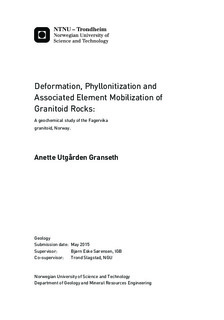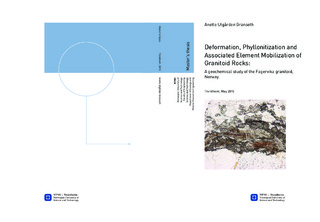| dc.description.abstract | The Fagervika granitoid is a felsic, peraluminous intrusion that was emplaced in oceanic crust at 481 Ma, now represented as the Bymarka ophiolite in Trondheim, Norway. It belongs to the Støren Group in the Upper Allochthon within the Scandinavian Caledonides. The emplacement onto the Baltican margin during the Caledonian orogeny occurred around 420 Ma, with following collapse in 400 - 380 Ma. Regionally, the rocks have been subjected to greenschist to lower amphibolite facies metamorphic conditions.
Detailed mapping at centimetre to decimetre scale of the Gråkallen area reveals the complex distribution of phyllonitic shear zones hosted by a granodiorite, with transport direction interpreted as a top-to-the-west movement. Field observations and petrographic studies were performed for mineral identification and textural descriptions. Comparison of the modal mineralogy with whole-rock data including trace elements is used to show chemical variation between the different lithologies. Mineral chemistry was examined with element mapping by Scanning Electron Microscopy (SEM), Electron Microprobe Analysis (EMPA) and Laser Ablation Inductively Coupled Mass Spectrometry (LA-ICP-MS). These methods report the major and trace element distribution along with the Rare Earth Elements (REE) distribution in each mineral phase. Isocon analysis of paired granodiorite-phyllonite samples enabled for quantification of the gains and losses in the system.
The rocks at Gråkallen are granodioritic, with only minor variations in modal mineralogy across all samples. The granodiorite is hypidiomorphic, show no preferred mineral orientation with early growth of mica and dynamic recrystallization of quartz. Phyllonitic shear zones have developed locally in the granodiorite and signs of widespread fluid interaction and metasomatism is evident throughout the rocks. The granodioritic assemblage is represented by Qtz + Pl + Kfs + Ms ± Py, with secondary accessories Ep + Aln + Ttn, which has been identified as the main REE-carriers. Allanite is enriched in the LREE, while epidote contains LREE to a lesser degree and titanite holds the HREEs, reflecting each minerals preferential affinity for the REEs. The feldspars are altered, with alkali feldspar neocrystallized to albite, and plagioclase is seritized and saussuritized, with widespread muscovite and epidote. Major elements Na and K have been mobilized and Ca to a lesser degree, while the REEs has only been mobilized at micro scale in the granodiorite.
iii
The phyllonitic shear zones trend approximately N-S and consist of elongated quartz grains in a muscovite matrix, defining the assemblage of Qtz + Ms ± Py ± feldspar porphyroclasts. The formation of the muscovite indicates the presence of water-rich fluid. The Ca-bearing accessories Ep + Aln + Ttn has been destabilized, along with most of the feldspar due to deformation and high fluid/rock ratio, though some titanite is remnant. In addition, the fluid composition enabled for mobilization of trace elements and REEs. This resulted in depletion of the REE, with a greater loss of LREE compared to HREE. An epidote-rich shear zone shows a high modality of epidote, along with Ms + Py + Qtz + Ttn, with subsequent REE enrichment in comparison to the granodiorite. The REE pattern of the epidote-rich shear zone appeared as an enriched version of the granodiorite REE pattern, suggesting that stabilization of epidote and titanite prevented loss of the REEs.
This study shows that metasomatism triggered mineralogical changes and grain size reduction, especially for the feldspars in the undeformed granodiorite, enabling increased fluid flow. The heightened fluid/rock ratio allows muscovite to form, and thus promoting strain weakening and further strain partitioning. Deformation and fluid-rock interaction completely changed the mineralogy by destabilizing feldspar and the REE-bearing phases and by forming muscovite, which promoted mobilization of K, Na, Ca and the REEs during phyllonitization of the granodiorite. | |

